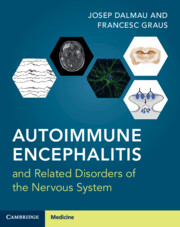Book contents
- Autoimmune Encephalitis and Related Disorders of the Nervous System
- Autoimmune Encephalitis and Related Disorders of the Nervous System
- Copyright page
- Dedication
- Contents
- Clinical Vignettes
- Videos
- Preface
- Abbreviations
- Section 1 Overview
- Section 2 Antibodies and Antigens
- Section 3 Specific Syndromes and Diseases
- Section 4 Autoimmunity in Neurological and Psychiatric Diseases
- Chapter 19 Autoimmune Psychosis
- Chapter 20 Psychiatric Manifestations of Autoimmune Encephalitis
- Chapter 21 Abnormal Movements in Neurological Autoimmune Disorders
- Chapter 22 Sleep and Autoimmunity
- Chapter 23 Immunity, Inflammation, and Epilepsy
- Chapter 24 Autoimmune Dementia: A Useful Term?
- Chapter 25 Frequently Asked Questions on Autoimmune Encephalitis and Related Disorders
- Index
- References
Chapter 25 - Frequently Asked Questions on Autoimmune Encephalitis and Related Disorders
from Section 4 - Autoimmunity in Neurological and Psychiatric Diseases
Published online by Cambridge University Press: 27 January 2022
- Autoimmune Encephalitis and Related Disorders of the Nervous System
- Autoimmune Encephalitis and Related Disorders of the Nervous System
- Copyright page
- Dedication
- Contents
- Clinical Vignettes
- Videos
- Preface
- Abbreviations
- Section 1 Overview
- Section 2 Antibodies and Antigens
- Section 3 Specific Syndromes and Diseases
- Section 4 Autoimmunity in Neurological and Psychiatric Diseases
- Chapter 19 Autoimmune Psychosis
- Chapter 20 Psychiatric Manifestations of Autoimmune Encephalitis
- Chapter 21 Abnormal Movements in Neurological Autoimmune Disorders
- Chapter 22 Sleep and Autoimmunity
- Chapter 23 Immunity, Inflammation, and Epilepsy
- Chapter 24 Autoimmune Dementia: A Useful Term?
- Chapter 25 Frequently Asked Questions on Autoimmune Encephalitis and Related Disorders
- Index
- References
Summary
In this chapter we have selected relevant questions that over the years many colleagues have asked us at conferences or in consultations. Some answers are straightforward, but others are difficult because they reflect grey areas in our knowledge of autoimmune encephalitis that require further research. The chapter includes 90 questions covering 14 general topics: definitions and general concepts, diagnostic issues, pathogenesis and mechanisms of disease, limbic encephalitis, anti-NMDA receptor encephalitis, autoimmune cerebellar/brainstem encephalitis, autoimmunity against the inhibitory synapses, neurological syndromes and glial antibodies, autoimmune and inflammatory encephalopathies as a complication of cancer treatment, autoimmunity and psychiatric manifestations, seizures and autoimmunity, autoimmunity and sleep, abnormal movements in neurological autoimmune disorders, and CNS syndromes at the frontier of autoimmune encephalitis. The answers are short, and we strongly recommend readers go to the suggested sections in the book and read the related references, where more comprehensive answers can be found.
Keywords
- Type
- Chapter
- Information
- Publisher: Cambridge University PressPrint publication year: 2022
References
- 1
- Cited by



